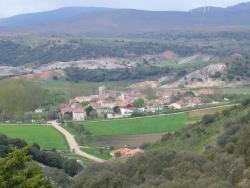Quintanalara

The history of Quintanalara is closely related to the history of Lara. A place with a great deal of vestiges from different ages that have left their mark in every corner of this village.
Visitors can see remains of the cultures that have existed here.
The Neolithic has left the Menhir of Cantohincado, as Miguel Moreno quotes in his web www.megalito.es
The Celtic peoples, pelendones and turmódigos, lived here.
The Roman empire, present in the whole area, filled the geography with roads to deliver goods. One of these roads, which connected Lara de los Infantes, Nova Augusta, with Monasterio de Rodilla, is thought to go along Quintanalara. It is not rare, as in some excavations there have appeared bricks used for the building of “hipocaustum” glorias.
Although there are no Arab vestiges left in this area, there is in this village a cave known as the Cueva del Rey Moro.
Quintanalara, as it happens with a lot of villages in this area, appears after a first repopulation among 860 and 977 (Antonio Palacios, Viaje al condado de Lara), whose name is mentioned in the Libro Becerro (1044) as Quintana de la Torre, being a behetría (free town) of Lara and Haro.
In 1352 it appears well documented in the Becerro de Behetrías under the jurisdictional regime of the Bujedo abbot (Félix Palomero, Agalsa).
In the 18th century the Catastro de la Ensenada mentions Quintalara with 160 inhabitants, 87 single, 64 married and 8 widowers.
In 1785 the earl of Floridablanca requires the intendant of Burgos to inform on the situation of all villages in the province, appearing Quintanalara as a crown place in the district of Can de Muñó. (Félix Palomero, Agalsa).
It was in the census of 1857 when this village was more populated than ever, 244 people.
From 1843 on Quintanalara had got its own town council, belonging to the judicial district of Salas de los Infantes. However, in 1978 it becomes an administrative junta depending on the town council of Revilla del Campo and, therefore, on the judicial district of Burgos.
Suscribete a nuestro boletín
Dolmenes, Arte visigodo, Románico, Naturaleza...
Todo el arte y la historia que puedas imaginar
Planifica tu peregrinación antes de salir
Dónde descansar, comer y dormir
Algunos consejos antes de hacer el camino de San Olav
Qué te puede hacer falta
















